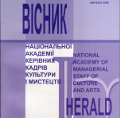ART PROJECTS AS HUMANITARIAN STRATEGIES FOR PSYCHOSOCIAL SUPPORT: INTERNATIONAL EXPERIENCE OF DEVELOPMENT AND IMPLEMENTATION
ART PROJECTS AS HUMANITARIAN STRATEGIES FOR PSYCHOSOCIAL SUPPORT: INTERNATIONAL EXPERIENCE OF DEVELOPMENT AND IMPLEMENTATION
Author(s): Oljgha OvcharukSubject(s): Education and training, Social development, Social Theory, Sociology of Culture, Sociology of Art, Sociology of Education
Published by: Національна академія керівних кадрів культури і мистецтв
Keywords: international art project; Mobile Arts for Peace; cultural and artistic practices; psychosocial support; humanitarian strategies;
Summary/Abstract: The purpose of the article is to substantiate the possibilities of using the international experience in the field of cultural and artistic practices as a humanitarian strategy for psychosocial support for children and youth in Ukraine under martial law, based on a cultural analysis of the implementation of the «Mobile Arts for Peace» (MAP) art project. The research methodology is to use interdisciplinary and comparative approaches to study the specifics of the therapeutic impact of various types of arts – theatre, music, visual arts, choreography in the implementation of international art projects in post-conflict societies. The main research methods are: the method of hermeneutic analysis – for the interpretation of works of art created within certain national cultures; the method of semiotic analysis –for revealing the meanings and values of artistic phenomena as sign systems; the method of psychological experiment – for analysing the results of using innovative artistic methods in the process of psychological support for project participants. The scientific novelty consists in summarising the international experience of developing and implementing the «Mobile Arts for Peace» art project in different countries of the world – Rwanda, Nepal, Indonesia, Kyrgyzstan; substantiating the possibilities of providing psychosocial support to participants in art projects as forms of cultural and artistic practices; identifying the features of the MAP project implementation based on the specifics of national cultural traditions, historical, and cultural memory, and the depth of cultural trauma in each society. Conclusions. The analysis of the process of implementing the «Mobile Arts for Peace» art project allowed us to summarise the international experience of engaging art as an effective tool for peacebuilding, establishing dialogue, and providing psychological assistance to societies in countries that have gone through various types of conflicts. The studied international experience can be successfully used to develop concepts, programs, and methodological recommendations adapted to the needs of Ukrainian society in the context of war.
Journal: Вісник Національної академії керівних кадрів культури і мистецтв
- Issue Year: 2023
- Issue No: 1
- Page Range: 29-35
- Page Count: 7
- Language: English

